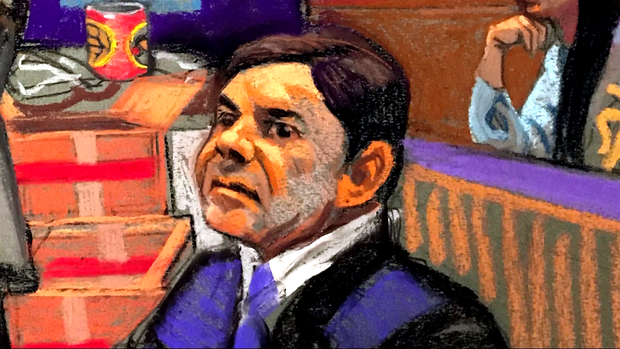The government gave its closing argument Wednesday against Mexican drug lord Joaquin "El Chapo" Guzman, describing his more than two-decade long career rising through the ranks and leading the cartel that flooded the United States with tons of cocaine. He faces multiple drug and murder conspiracy charges that could land him in jail with a life sentence if convicted.
Assistant U.S. Attorney Andrea Goldbarg spent the bulk of the trial's 37th day in a Brooklyn federal court explaining the first of 10 counts Guzman is facing: engaging in a continuing criminal enterprise.
She discussed how evidence showed how over 25 years, Guzman led the Sinaloa cartel. The beginning of her presentation started like a storybook could: "High in the mountains of Sinaloa ..." but went on to explain the violent point-blank murders of two members of the rival Zeta cartel.
From there, she used a flurry of words to illustrate 11 weeks worth of memories from the jurors: "drugs, money, violence, cocaine, heroin, meth, torture, murder." This all equaled, according to Goldbarg, "billions in profit." She urged jurors to use "common sense" when it comes to determining his guilt. It's based on "an avalanche of evidence" presented by the government. And she thanked them "on behalf of the United States Government."
The defense insists the allegations are fabricated.
Jurors listened once again to phone calls, saw text messages and walked down a virtual memory lane of evidence, including photos showing Guzman holding his diamond pistol and others with his gold AK-47, which are a blatant violation of Count 9, using a firearm in a drug trafficking crime.
After every moment like this, Goldbarg affirmed to the jury the government has proven, beyond reasonable doubt, Guzman committed the crimes he's been charged with. There are 10 counts in all; Count 1 contains 26 felonies in itself.
"He's responsible for any acts committed by the cartel," Goldbarg said. "It was his orders, his actions."
She even explained the jurisdiction of this case and why we are here, in the Eastern District of New York. In 2002, more than 1,900 kilos of cocaine were seized from a warehouse in Brooklyn "...not far from this courthouse." At the time, it was the largest seizure of cocaine in the state's history.
Part of the government's burden is to show Guzman made substantial income. Count 1 contains three qualifying questions, including: Did defendant enterprise receive $10 million or more in gross receipts during at least one 12 month period? Goldbarg illustrated the government's evidence and again asked jurors to rely on their common sense. In a three year period between 2000 and 2003, the government estimates Guzman made $700 to 800 million. "This far exceeds what the government has to prove," she said.
Counts 2, 3, 4 deal with conspiracy to import and distribute drugs into the United States. "Even if drugs never made it ... even if the defendant never set foot in this country, he's guilty of conspiring in international drug trafficking," Goldbarg explained.
Counts 5, 6, 7, 8 address international drug trafficking. These are the same offenses as laid out in Count 1.
Count 9 is the use of firearms: "They all saw the defendant carrying a firearm, but his firepower was not limited to pistols," Goldbarg said. The government explained Guzman routinely used AK-47s, AR-15s and bazookas, according to witness testimony. This count also charges him with aiding and abetting other crimes, such as providing his security guards with firearms and vests. "This wasn't a bring your own firearm situation," Goldbarg said.
Count 10 deals with money laundering conspiracy and what Guzman did with the money. The government argued Guzman knew the money was from drug trafficking, transferred it, agreed to launder it and put the profits back into the business. There was "overwhelming evidence" he moved the money across international borders (i.e. between the U.S. and Mexico).
There was very little activity from the defense table Wednesday. At times, Guzman was seen writing in a big yellow legal pad and gesturing toward one of his attorneys. His wife Emma was in the courtroom as well as the Netflix actor who plays Guzman.
"The defendant had a plan to conquer the drug world," Goldbarg said as she was concluding. "He was ready to do anything. Bribery, torture, murder ... always one more option: to escape."
"Why did he escape? Because he knew he was guilty," she said. "He wanted to avoid sitting right there in front of you ... do not let him escape responsibility. Hold him accountable for his crimes. Find him guilty on all counts."
Court resumes Thursday morning with the defense team's closing argument. Considering how they only called one witness to mount a 30-minute defense of their client, the jury could get this case in short order.


No hay comentarios:
Publicar un comentario